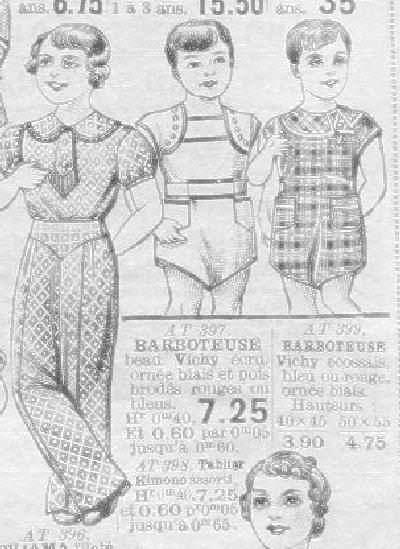
Figure 1.--This advertisement appeared in a March 1936 La Samaritaine catalog. Pictured are a boys romper, shorts set, and child's coat.


Figure 1.--This advertisement appeared in a March 1936 La Samaritaine catalog. Pictured are a boys romper, shorts set, and child's coat. |
A La Samaritaine department store ad in March 1936 offered two more romper suits. They were tghe regulat non-puffed pants style. Also pictured with the boys' rompers or girls' pajamas. A smock is mentioned, but not illustrated.
La Samaritaine is either the earliest or at least one of the earliest department stores ever built. Situated in the historic center of Paris, between the Louvre and Châtelet and opposite the Ile de la Cité, the famous department store got its name from an old water pump near the Pont Neuf. The water pumps were very important to people in the 19th century. This pump for example fed the Louvre. It was something of a landmark because it was decorated with the woman of Sameria giving a drink of water to Jesus. The store now occupies four buildings. The café on the roof of store number two offers a 360 degree view of Paris. La Samaritaine has always been something of a poor relation in the department store stakes, but since it has been acquired by the LVMH group (owners of Le Bon Marché) this is probably due to change. You can find just about anything in the chaotic four-store complex, from fashion to household goods, a large linen department and a big toy department. Building two has a faded charm with wonderful art nouveau details, a superb Seine location and a great view from the rooftop terrace. The view is also excellent from the fifth-floor restaurant Le Toupary.
A La Samaritaine department store ad in March 1936 offered two more romper suits. They were tghe regulat non-puffed pants style. Also pictured with the boys' rompers or girls' pajamas. A smock is mentioned, but not illustrated.
Thes girls' pajamas were availabe in sizes from 2-18 years of age.
The ad copy reads, "Barboteuse beau Vichy écru, ornée biais et pois brodés rouges ou bleus. Hr 0m40 Fr 7.25. Et Fr 0.60 par 0m05 jusqu'a 0m60." This would translate as, "Romper made of good quality flat finish gingham, [?ornée biais et pois brodés] red or blue. 40 cm Fr 7.25. And Fr 0.60 for each additional 5cm through 60 cm." The detailing of this romper seems rather elaborate and it cost almost twice as much as the one next to it. It was for boys 2 to 6 or 7 years of age.
The smock mentined in the ad coopy is not illustrated. The ad copy reads, "Tablier Kimono ??? Hr 0m40 Fr 7.25 et Fr 0.60 par 0m05 jusqu'a 0m65." This would translate as, "Kimono smock ??? Height 40 cm Fr 7.25. And Fr 0.60 for each additional 5cm through 65 cm."
We assume that since it is called a Kimomo smock that it was a style for girls.
The ad copy reads, "Barboteuse Vichy écossasis bley ou rouge, oenée biais. Hauteurs 40-45 cm Fr 3.90. 50-55 cm Fr 4.75." This would translate as, "Ginham romper blue or red Scotch plaid. [?ornée biais] Height 40-45 cm Fr 3.90 50-55 cm Fr. 4.75." And Fr 0.60 for each additional 5cm through 60 cm." It was for boys 2 to 5 or 6 years of age.
La Samaritaine was patrionized by a clientelle of more modest means than the other large Paris department store. We wonder if this may be part of the reason that both children wearing the smocks are girls on another part of the page and that the rompers (barboteuses) pictured here are not the puffed pants style. Perhaps that stylish school smocks and puffed pants rompers were more common with more affluent customers. A French reader, however, tells us, "This is not the exact raison. The puffed pants
rompers were aloso being worn in the 1930s, but were not in fashion. At this time rompers were vety common, worn both during warm summer days, but even on
cold days. Syyles changed significantly for little bots during 1936-37. At this time the puffed pants romper became much more fashionable and the older regular style
pants became much less common. About the smocks: These models were used by all the french class, poor and rich."
French catalogs vary in how they do sizing. Some provide sizes in terms of the child's age. This was especially common for younger children. Others stores present sizes in centimeters (cm). Note that this can be confusing. Not only did stores have varying practicesm, but these practices changed over time. Another complication is that modern children are slightly taller than children in the early 20th century. Of course there is also te complication that there are substantial cariations among children in any given age group. While there are a number of variations here, French readers have provided us size/age equivalents to provide some rough indications as to the sizes of individial garments. The size equivalents used here are explained at this link.
Navigate the Boys' Historical Clothing catalog/magazine pages:
[Return to the Main French 1936 ctalog page]
[Return to the Main retail store alpahavetical M-Z list]
[Return to the Main store page]
[Fashion magazines and store page]
[Main photo/publishing page]
[Fashion magazines]
Navigate the Boys' Historical Clothing Web Site:
[Introduction]
[Activities]
[Biographies]
[Chronology]
[Clothing styles]
[Countries]
[Bibliographies]
[Contributions]
[FAQs]
[Glossaries]
[Satellite sites]
[Tools]
[Boys' Clothing Home]
Navigate the Boys' Historical Clothing Web Site:
[Sailor suits]
[Sailor hats]
[Buster Brown suits]
[Eton suits]
[Rompers]
[Tunics]
[Smocks]
[Pinafores]
